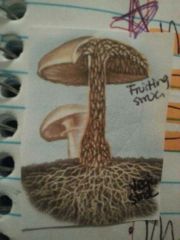![]()
![]()
![]()
Use LEFT and RIGHT arrow keys to navigate between flashcards;
Use UP and DOWN arrow keys to flip the card;
H to show hint;
A reads text to speech;
11 Cards in this Set
- Front
- Back
|
Absorptive Heteroptrophy
|
Digestive enzymes are secreted to break down large food molecules in the environment
|
|
|
Multicellular Fungi
|

Body - mycelium
Hyphae - individual tubular filaments Cell Walls - strengthened by polysaccharide chitin |
|
|
Chitin
|
Polysaccharide that streghtens cell walls of multicellular fungi
|
|
|
Septate
|
Fungi species that hyphae are subdivided by incomplete crosswalls called septa
Organelles can move bw compartments |
|
|
Coenocytic
|
Fungi species with no speta but many nuclei
|
|
|
Importance of Fungi
|
Important to ecosystem functioning
Decompose dead organisms, cellulose, keratin, and recycle mineral nutrients Carbon cycle would fail w/out them - C would be buried instead of returned to atmosphere |
|
|
Saprobes
|
Absorb nutrients from dead organic matter
Declined during Carboniferous Period Flourished through extinctions esp. Permian |
|
|
Parasitic
|
Absorb nutrients from living hosts
Facultative: can grow on living organisms Obligate: can grow only on their specific host Pathogens- lethal to ppl with comprised immune system; ringworm and athletes foot Predatory- trap microscopic protists or animals |
|
|
Mutualistic
|
Live in intimate association with other organisms that benefit both partners
|
|
|
Lichens
|
Mutualistic association of a fungus with a cyanobacterium, photosynthetic alga, or both
Found on rocks and harsh environments |
|
|
Soredia
|
One or a few photosynthetic cells sorrounded by hyphae that disperse on air currents
|

